Black Blood Python For Sale | 1 Best black blood python…
$199.99
Black Blood Python For Sale, are typically 12-15 inches long and have a dark red or black coloration with black markings. They have a short tail
Short Tailed / Blood Pythons are a beautiful, interesting species for the intermediate to experienced snake keeper. In this Blood Python care guide I’m going to cover the three different species of Short Tailed Python (including the Blood Python) you’re likely to see in captivity and their housing, heating, lighting, feeding and more.
Meet the Short-Tailed Pythons
There are three species of Short-Tailed Python and you can see them all in the pet trade. You may see all three referred to as Blood Pythons, which can be confusing, as Python brongersmai is often simply referred to as the Blood Python, therefore for clarity and to avoid confusing the three species, I’ll be referring to them as Short-Tailed Pythons.
Short-Tailed Pythons inhabit tropical swamps and marsh land, are entirely terrestrial as adults, although juveniles may take advantage of cover in low bushes and trees and interestingly, are primarily crepuscular rather than nocturnal. They’ll hunt most often at dawn and dusk and not through the night. It’s hard to get an accurate estimate of captive bred lifespan as many individuals do not make it to old age, but conservative estimates put lifespan at twenty years with correct care.
All three species reach approximately four to five feet as adults, with males being smaller than females. There are always outliers; a small male could be three foot, whilst a large female could reach six foot. The weight is 10 to 15 lbs, considerably less weight than some of the larger species, but still a heavy weight for the length, when you consider that this is the same length as a Royal Python, who reaches around 2 to 4 lbs!
Red Short-Tailed Python / Red Blood Python (Python brongersmai)
This is the most common species you will see in captivity. You’ll see it referred to as a Red Blood Python, Red Short-Tailed Python or Brongersma’s Short-Tailed Python. The Red Blood Python comes from western Malaysia, Sumatra, Thailand and islands in the Strait of Malacca. As the name suggests these have a red hue, with beautiful orange, cream and black markings. The Red Blood Python tends to be the largest of the three species.
Borneo Short-Tailed Python / Borneo Blood Python (Python breitensteini)
Borneo Blood Pythons or Borneo Short-Tailed Pythons are much darker than Red Blood Pythons, with a base that varies from dark brown to tan, with black, white and brown markings. In the wild they are only found on the island of Borneo. You may also sometimes see them referred to as Borneo Blood Python.
Sumatran Short-Tailed Python / Black Blood Python (Python curtus)
This is the darkest of all three species, often with black, grey and silver markings. Some may have yellow or orange on them, particularly as hatchlings. As they age, they darken. These pythons can be found in Sumatra, and are sometimes referred to as the Black Blood Python. The Sumatran tends to be the smallest on average of the three species.
Why are Blood Pythons an “Intermediate” or “Advanced” Snake
if this is your first snake or you’re not experienced with snakes, if you’re shopping for a child or a family pet, then a Blood Python is most likely not suitable. It’s very rare that I say this – for example I’d describe a common boa constrictor as intermediate, but say that people can still keep them as family pets or as first time snakes given research and understanding. This is not the situation with Blood Pythons, I would put captive bred individuals in the intermediate camp, whilst wild caught individuals I’d list as advanced, especially certain localities.
Blood Pythons are a heavy bodied short length snake which can be hard to handle due to their weight distribution. They have large teeth and can do serious injury as their strike has a very high force behind it. Wild caught individuals are often outright aggressive, as this is how they have had to survive, as well as some localities having fierce tempers. Captive bred individuals are often much more placid and have made this snake more accessible as a pet, but this is still an alert and often unpredictable snake that requires a confident handler. The actual care needs are a little bit more complex than most snakes although you should be able to set up the correct enclosure with by following this guide. Hatchlings can be quite sensitive to the environment. Feeding can be tricky as well, particularly for wild caught individuals and many wild caught blood pythons will only feed on live prey, or need to be assist fed.
That being said, Blood Pythons are a stunning snake with interesting behaviours that many experienced herpetologists will enjoy. As long as you are an adult who has researched and understood their foibles, then this might be the right animal for you. Buying captive bred goes a long way towards removing most of the problem behaviours associated with Blood Pythons, but unfortunately these are still seen wild caught more often than captive bred in the UK so always buy from a trusted source.
Buying a Blood Python – Wild Caught vs Captive Bred
Here at Reptile Cymru we try to stock captive bred animals wherever possible, but sometimes species are only available wild caught, either due to their low cost, or difficulties breeding them in captivity. Blood Pythons are not an inexpensive snake, prices usually ranging from £150 up to £500 or more, so the main reason they are still imported into the country is simply that they do not breed readily and we do not have a good supply of captive bred babies available in the country.
Buying a wild caught animal has both ethical and care implications. This animal has been removed from the wild legally because it is not endangered, but it’s often hard to know exactly what numbers of reptiles exist in the wild and how heavily the pet trade, as well as other ongoing problems such as habitat destruction are affecting their numbers. An animal born in the wild will have had to survive predators and find live prey, then been captured and shipped across the world, often in very cramped conditions with hundreds or even thousands of other reptiles. This can result in an animal that is stressed, defensive, views humans as a threat, and also an animal that is used to eating live prey and may be more difficult to get feeding. In addition to this, the import conditions in my experience almost always result in the spread of parasites, both internal and external.
If you are buying a wild caught animal of any kind please buy from a reputable seller who has quarantined and treated this animal for any health problems, and taken the time to acclimitize the animal to captivity and got them feeding on defrost rodents. This should be the responsibility of the seller to provide you with a healthy animal, yet all too often animals are imported into wholesalers, shipped to pet shops, and sold into homes within days where the ultimate buyer may then struggle. Blood pythons are already an unpredictable snake with more advanced care needs than average, if you are adding wild caught to the mix then it bumps this up to advanced requirements rather than just intermediate, so think about it carefully and be prepared for additional needs.
Blood Python Housing
An adult Blood Python will need an enclosure that’s a minimum of 48x24x24″. You may want to provide more space for a larger individual, particularly larger females. Due to their humidity requirements you will want to well seal the enclosure, as well as ideally add pond lining or similar to the bottom of the tank to make sure your vivarium lasts as long as possible. With high humidity species you will tend to need to replace your vivarium more often than dry species, as the water does get into the wood. It may need to be replaced every five years or so.
Juveniles do well in smaller enclosures and can be kept in plastic or glass tanks if you can get the required humidity and temperatures. Wood is recommended because of the heat and humidity requirements and the ease of installing electrics.
Heating and Lighting
A small basking area should be provided of around 86 – 88 F (30 – 32C). It is important not to go above these temperatures, as this snake doesn’t tolerate high temperatures well. The overall ambient of the cage should be 80 – 82F (26 – 27C). The temperature in their wild environment does not drop significantly at night. The cold end of the tank, and the night time temperature, can be around 78F (25C).
We do not recommend heat mats with Short Tailed Pythons. As a heavy bodied snake, they can put a lot of pressure when lying direct on a heat mat which can cause burns even if a heat mat is controlled with a thermostat. In addition, heat mats cannot obtain the desired temperatures in large enclosures. Ceramic heating elements heat the air rather than the ground and this creates a more natural and stable source of heat as well as being available in a wide range of strengths to suit larger enclosures. If you do need to use a heat mat as a supplementary source of heat for some reason, make sure it is taped to the back of the enclosure and not the ground.
Controlling Temperature – Thermostats – A thermostat controls the temperature of the device it is attached to. These are simple devices that can help maintain the temperature at optimum, which helps with the overall health of the animal. Both extremes of hot and cold can be very damaging to reptiles, as they cannot regulate their own body temperature like mammals. A thermostat is an essential piece of equipment for the responsible owner.
Measuring Temperature – Thermometers – In the best case scenario you will know what the temperature is on the hot and cold end of your tank as thermostats can fail or be inaccurate, so you want to take manual readings regularly.
UVB Lighting
Whilst UVB is not a requirement for a healthy Blood Python / Short-Tailed Python, we now recommend UVB as best practice with all snakes. Short Tailed Pythons are often awake and active at dawn and dusk in the wild, which means they would get some natural UVB in the wild. Read our complete guide to UVB bulbs here.
Your UVB bulb must be guarded because the snake could potentially burn themselves on it, even though Short-Tailed Pythons are not climbers, they might investigate it and you’ll be surprised at what they can reach! A T5 7% Shadedweller kit, or equivalent forest UVB (T8 6%) bulb will be fine for this species.
Water and Humidity
You should have a large water bowl available with fresh water changed daily and if a large enough water container is provided this is a species that will quite happily soak in water. Watch that it is sturdy though, as their weight can easily tip bowls.
Humidity for Blood Pythons and Short Tailed Pythons is very important. Keepers often mistake this for meaning keep the tank soaking wet, which can easily result in respiratory infections, especially in hatchlings and juveniles who can be quite sensitive. You’ll need to keep your humidity at 60 – 70%. In a vivarium you may want to test this out before getting the snake. You can obtain this humidity with spraying the tank, most likely two to three times daily, as well as having a large water bowl on the warm side of the tank, and a deep substrate that allows for some moisture to be retained, without being wet or marshy.
A humidity too low will result in shedding problems, so if your Blood Python or Short Tailed Python is having problems shedding, this is a solid indicator that your humidity is too low.
Substrate and Decor
Use a natural substrate that can hold humidity without mold growing – for example Orchid Bark, EarthMix or Coir. Blood pythons will naturally burrow to avoid predators, so adding a deep enough substrate that they can burrow in will both help humidity and provide a natural behaviour for them. Just be wary of a buried Blood Python when it comes time to clean the tank out – they will ambush based on movement, so make sure you’re aware of where they are!
You’ll want some large hides on both sides of the tank. Commercially made hides are not big enough for adult Blood Pythons, but you can use large pieces of cork bark, or fashion your own hides from plastic or polystyrene.
You can add some study branches and plastic plants, although this a terrestrial snake, they do explore their surroundings, and hatchlings or juveniles may choose to climb.
Housing Short Tailed Pythons together
Snakes don’t have social needs and adding two snakes to an enclosure means you need a lot more space and hiding places. Although you may think that snakes cuddle up together, this is actually usually because they are competing for the most popular spot. It can already be quite difficult to provide adequate space for an adult short tailed python, having more than one to a tank makes this task more complex, and there are no benefits for the snake. We’d highly recommend housing short tailed pythons separate unless specifically intending to breed. If you do intend to breed then you should always ensure you are breeding the same subspecies so the people buying the babies are confident in their source.
You should never house short tailed pythons with any other species of snake.
Short Tailed Python Vocalisation
Vocalisation isn’t something you would expect from a snake, but like some other species, such as the Western Hognose, Blood Pythons and Short Tailed Pythons can be particularly noisy. Hissing is a defensive sound that shows you the snake feels threatened, whilst huffing and puffing are completely normal, particularly whilst interested and alert or being handled. Don’t confuse any hissing as an immediate respiratory infection (which these snakes can be prone to in the incorrect conditions), so if you are worried about respiratory conditions, look for other symptoms as well such as blowing bubbles, mucous in the mouth or nose, visible gunk in the mouth or nose, problems using the tongue, going off food, and so on. A respiratory infection sounds like a much more serious wheeze and rattle than the normal noises as well.
Handling your Short Tailed Python
Blood Pythons and Short Tailed Pythons can be tricky to handle, but for the confident handler they can still be given plenty of exercise outside the enclosure. As a heavy bodied snake that spends almost all of it’s time either on the ground, or burrowing in substrate, being suddenly lifted into the air can be very stressful. It’s critical that the snake feels fully supported at all times, but sitting down puts you in a position where you can’t move away if the snake strikes. Supporting the snake with one arm fully whilst using the other hand to handle with a hook if necessary can build confidence and rapport between the two of you. Each python does have it’s own personality, and although this can be an unpredictable species, with time you’re likely to understand your snakes movements and manners.
We recommend using a hook with this species for removing them from the vivarium, which supports their body and maneuvers them without you having to lean into a small space such as a vivarium to reach for them. It also allows you to remove them safely should they need to be removed for health reasons, cleaning or feeding, even if they are in a bit of a mood and disinclined to be moved!
Feeding your Blood Python / Short Tailed Python
Although this snake has considerably weight and girth, they actually have a slow metabolism and a very efficient digestive system. They also have a large appetite, which means in captivity it’s very easy to get an obese Blood Python – something which results in heart problems, organ failure and reduced lifespan. Do not be tempted to overfeed. Juveniles should be fed every 7-10 days, whilst adults can be fed every 14 days, but overweight individuals or individuals prone to putting on weight due to inactivity can be fed every 21 days.
Hatchling Short Tailed Pythons, particularly wild caught individuals, may be difficult to get feeding immediately onto thawed mice. As we don’t live feed in the UK, you should always buy from a breeder or shop that has made sure your snake is well established and feeding consistently on defrost. They rely heavily on heat sensing from their heat pits, so ensure that your defrost prey is well warmed and not at room temperature, but not so hot it will explode on impact. Defrosting in hot but not boiling water can achieve a good body temperature for your rat. Some snakes do not like wet defrosted items and the act of drying can decrease the prey’s temperature, in which case defrost inside a sealed bag so that it stays dry.
Always feed with tongs, this is a snake with a very long reach for it’s size and you don’t want any accidental mishaps happening with your fingers!
As a note on the digestive process, this is a snake that has a much longer digestive process than other species and defecates infrequently. It is not uncommon for a Blood Python or Short Tailed Python to go months without defecating and they will continue to feed every week in that time. Generally speaking adults fed every 10 days will poop once every 30 days, whilst adults fed every 14 days will poop every 45 days – but going twice as long shouldn’t be alarming. As long as your temperature and other conditions are correct, long durations between defecation is just normal for this species.

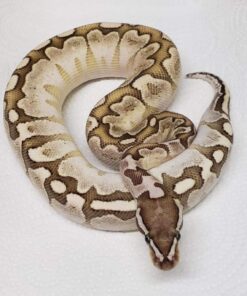
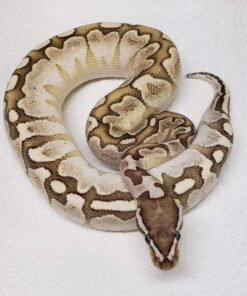
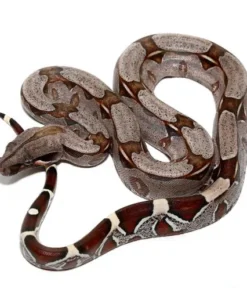
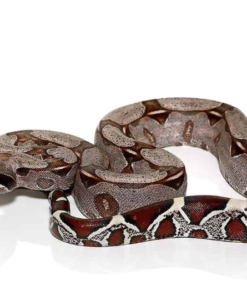
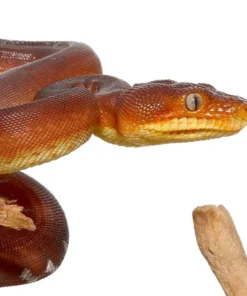
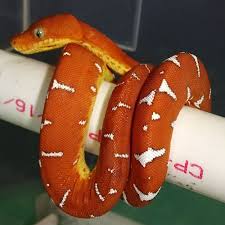

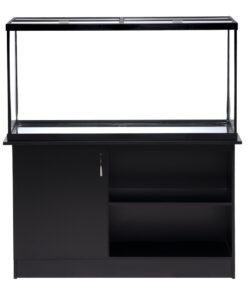


Reviews
There are no reviews yet.